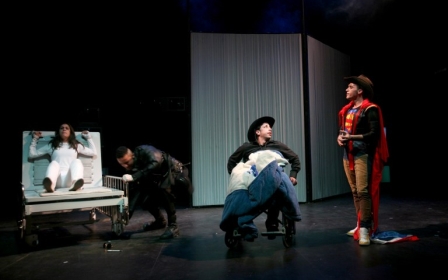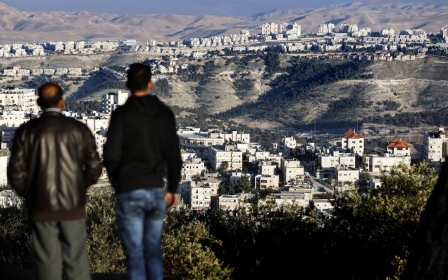From father to son: How the Palestinian struggle is passed from one generation to the next

In August 2002, two years into the Second Intifada, Israeli forces closed in on a local Hamas leader in the West Bank village of Tubas near Jenin.
Nasser Jarrar was in a wheel-chair having lost both legs and an arm in an explosion. A 19-year-old neighbour of Jarrar, Nidal Abu M'Khisan was given a flak jacket and forced at gunpoint to act as a human shield for troops storming the house.
Jarrar opened fire and killed the youth, before himself being buried alive when the Israeli troops bulldozed the house.
A war crime
Before he died, Nasser gave a Quran to his son Ahmad who was seven at the time. The inscription written with his remaining left hand read: "A gift to my dear son Ahmad."
Four months earlier, a notorious Israel military operation took place when their forces surrounded and sealed off Jenin refugee camp. What followed was a 12-day battle in which infantry, commando forces, assault helicopters and armoured bulldozers were used to clear the camp, regarded by Israel as the suicide-bomb capital of the West Bank.
A closely packed residential area a third of a mile wide was reduced to dust; an Israeli infantry column walked into an ambush and Palestinian eyewitnesses claimed hundreds of bodies were buried in the rubble and were disposed of before international aid organisations were allowed in.
The Jarrars of this world can be killed. The Jenins of this world can be bulldozed and rebuilt. But one thing will not happen. The fire of this conflict will not be put out
When it was all over, an equally ferocious war of words began over what had happened in the refugee camp.
The Independent, Guardian, and the Times called it a war crime, a massacre, and Israel's September 11. Haaretz and the New York Times claimed the number of dead was limited and suggested most of them were militants.
Six weeks later, Yediot Aharonot published an interview with an operator of an armoured D 9 bulldozer who took part in the operation. Moshe Nissim said: "I didn't see, with my own eyes, people dying under the blade of the D-9 and I didn't see house[s] falling down on live people. But if there were any, I wouldn't care at all …
The Israeli army chief of staff at the time was Shaul Mofaz who urged officers to speed the operation up, instructing them to fire five anti-tank missiles at every house before entering. Mofaz, a former leader of the centrist Kadima party, is today regarded as a liberal on the spectrum of Israeli politics, and especially in comparison to the hawks in the cabinet.
A UN fact-finding mission found that at least 52 Palestinians had been killed, half of them civilians.
Smile and Hope
When the Second Intifada was over, a huge effort was put into rehabilitating Jenin. The former stronghold of suicide bombers was turned into "the quietest town in the West Bank" - or that is how it was written up.
Jenin, with its "special Palestinian economic and security zone" became a laboratory for a plan to be rolled out in the rest of the West Bank. It would be transformed.
Under what was called the Jenin pilot security project launched in 2008, Israeli soldiers would be withdrawn from the streets and the PA would reestablish control by deploying security units trained by the Americans. It was called "Smile and Hope".
The Palestinian prime minister, Salam Fayyad, called it the "Jenin model". Tony Blair, the international envoy, unveiled a package of measures to boost the economy of the West Bank including an industrial park in the Jenin area, with 30 factories, employing 25,000 people.
The burning embers of this struggle will be passed from one generation to another
In fact, the plan to put an industrial park near Jenin dated back to 1995 when Israelis flocked to the border town, where prices were low, and when a peace deal seemed to be around the corner. Jenin's industrial park has been re-announced and relaunched ever since.
Jenin's American University became the only Palestinian university whose degrees were recognised in Israel, and attracted some 3,500 Palestinian students with Israeli citizenship. One of those students was Ahmad Jarrar.
Jenin's governor at the time, Qadura Mousa, told the Portland Trust in November 2008 that security and the economy went hand in hand. It all depended on the number of customers that Israel allowed into Jenin through the Jalame border crossing.
Some saw in this an economic boost, others a form of bondage which would ultimately give Israel more control over the Palestinian economy and jobs. Jenin would be turned into a northern Palestinian gateway to Israel.
In 2009, Jenin's governor hosted Blair and the then US secretary of state, Condoleeza Rice, saying the industrial park could be a model, while also warning that security and economics were not enough.
"Society cannot settle only with security or economic changes. It also needs a political angle. These checkpoints, this constant talk of excessive security, this makes us think that there is no Israeli partner for peace," Mousa said.
Lots of smiles, but little hope. I checked on the status of this much-heralded industrial park, which has been about to open for 28 years. Kamal Abu Alarab, deputy governor of Jenin, said that a land dispute has been settled and they expect work on the park to continue. The park itself still has not started.
Job done?
This week another part of this story came to end. Ahmad, now 22 years old, was cornered by the Shabak and Israeli army units in the village of Yamoun, nine kilometres from Jenin. Wanted for being behind the drive-by shooting of a settler rabbi, Raziel Shevah, near an illegal outpost near Nablus on 9 January, Jarrar had spent almost a month on the run.
Everyone around him seemed surprised that this gregarious 22-year-old with a beaming smile and a large circle of friends, and who had graduated with a marketing degree from the university in Jenin, had chosen the same path that his father had 15 years ago.
Amer, a cousin, said: "We learned of his death this morning from the Israeli media ...We are stunned. None of us had any idea about his whereabouts."
Ahmad even died a similar death to his father's. The trail of destruction of the Israeli manhunt was large. On 28 January, his cousin Ahmad Ismail Jarrar was killed in a 10-hour operation in Wadi Bruqin. Three houses belonging to the Jarrar family were demolished.
On Sunday Wadi Bruqin was raided again and a 19-year-old Palestinian shot in the head. According to residents quoted by Al Jazeera, Israeli soldiers threatened to demolish the village house by house, until Ahmad turned himself in. Jarrar died in a hail of gunfire, surrounded by magazine clips.
Jarrar's body was taken by the Israelis. His relatives found a pile of bloodied clothes and a torn copy of the Quran his father had given him all those years ago. That, too, had been shot through.
The moral of this tale is stark: the Jarrars of this world can be killed. The Jenins of this world can be bulldozed, rebuilt, rehabilitated. Millions of dollars of EU money can be spent to transform Jenin.
But one thing will not happen. The fire of this conflict will never be put out. That will only come when the occupation ends, when justice is addressed, when Palestinians enjoy the same civil, property and political rights that Israelis do.
Until then, the burning embers of this struggle will be passed from one generation to another. Ahmad Jarrar has, in his turn, become a symbol. Hamas called him the pride of Palestine.
The leftist Popular Front for the Liberation of Palestine ( PFLP) called him an "influential national symbol Palestinians will be proud of".
Another symbol of Palestinian resistance, Ahed Tamimi, 17, faces months in prison for slapping an Israeli soldier in protests in the West Bank. She too had grown up in the relatively prosperous district around Ramallah.
On Tuesday, the Israeli Defence Minister, Avigdor Lieberman, tweeted in praise of the Israeli operation: "The score has been settled." Job done, Lieberman boasted.
Is it, really?
- David Hearst is editor-in-chief of Middle East Eye. He was chief foreign leader writer of The Guardian, former Associate Foreign Editor, European Editor, Moscow Bureau Chief, European Correspondent, and Ireland Correspondent. He joined The Guardian from The Scotsman, where he was education correspondent.
The views expressed in this article belong to the author and do not necessarily reflect the editorial policy of Middle East Eye.
Photo: Palestinians hurl stones towards Israeli troops during clashes in the West Bank city of Jenin, January 18, 2018 (REUTERS)
This article is available in French on Middle East Eye French edition.
Stay informed with MEE's newsletters
Sign up to get the latest alerts, insights and analysis, starting with Turkey Unpacked
Middle East Eye delivers independent and unrivalled coverage and analysis of the Middle East, North Africa and beyond. To learn more about republishing this content and the associated fees, please fill out this form. More about MEE can be found here.







